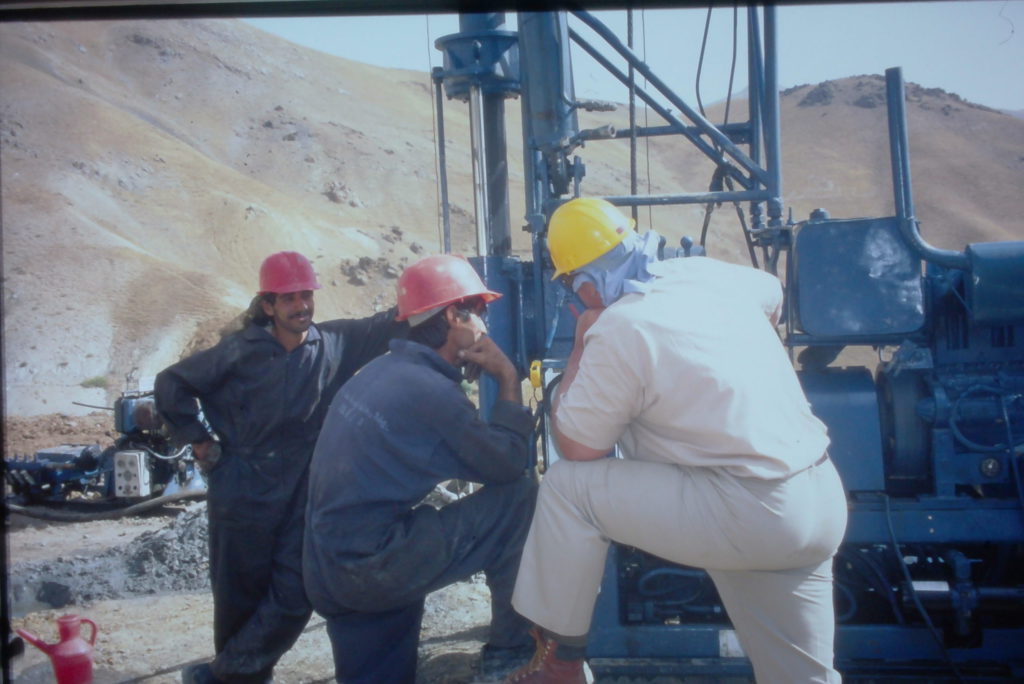
I was never really one for keeping a diary; I’m basically too lazy, and not nearly introspective enough. The only time I did keep one, it was by accident. In 1996 I was sent to Iran to supervise a drill program at a gold project called Zarshuran. It didn’t go well. A perfect storm of terrible rock conditions and inept local drillers doomed us before we’d even started. The drillers were the most comical I have ever hired; they lacked talent and common sense, and the managers couldn’t be trusted to sit the right way on a toilet. We drilled seven holes in three long months and they cost us a whole world of pain and frustration, yielding awful core recoveries and not enough data to make a decision on the project.
I faxed a daily drill report to London via a dodgy satellite phone at the camp. As summer dragged into autumn and winter set in, we were only getting 1-2 metres of core a day, the water pipes froze every night, and my daily reports got more and more fraught until drilling finally ground to a halt. Happily, my boss at the time (thanks Dave) realized a) that I was documenting a slow decline into lunacy, and b) kept the daily reports, bound into a single document; a diary of my misadventures which was presented to me at the office Christmas party that year. This piece is based on the daily faxes which I still have, 26 years later.
Zarshuran (“The place of the gold washing”), was 7,500 ft. up a mountain, six hours northwest of Tehran. It’s a Getchell-style Carlin gold system which had an active arsenic mine hosted in marbles (arsenic and gold often go hand in hand in similar gold systems in Nevada.) Rather than bring in a western drill company and battle Iranian customs for months, we decided to use an Iranian drill contractor that I’ll call COREO. They claimed that they could handle diamond core drilling, so we hired them after a due diligence visit to a drill site near Shiraz where they were drilling concrete grout holes in crumbly bedrock for a dam project.

Mobilization took a month and it was obvious from the start that COREO were a gong show. We knew the rock would be challenging, but we naively thought that COREO had the personnel and gear to handle it. They were to provide two wireline core rigs that could handle PQ core and triple tube drilling for the expected bad ground. Two rigs duly arrived on some very old trucks, but COREO’s management had decided that sending drill rods and drillers to operate the machines and twiddle the rods about was an unnecessary inconvenience and we could do without them.
When two drillers finally did arrive, they had no accommodation, food, or toilets. They were kipping in a 12-metre container and using the hillside as their loo, which made soil sampling somewhat hazardous. One of my early reports noted dryly “morale is generally at a low ebb due to the poor living conditions and lack of head office backup.”
COREO eventually sent a project manager to site, Mr. Paknejad, who at first tried to manage the project remotely from his office 1,000 km away in Shiraz. In the one and only site meeting we had, akin to trying to have a calm chat with an hysterical five-year-old, he told me that “…mobilization would finish when he said it was finished and not before, and anyway who were we to question him (hint: the client) and besides, he was doing us a huge bloody favour sending anything to site.” He then jumped in his truck and buggered off to the nearest town to make a phone call to head office. He never returned, judging correctly that the bad-tempered foreigners who’d questioned his competence might not welcome him back on site.
A few days into the drill program and progress was painfully slow, as little as 2-3 metres per shift. We did what we could with the gear available, advised by Dave, an experienced Australian drilling consultant we’d retained to knock COREO’s crew into shape. Dave was a force of nature. Built like a haystack, his eyes looked in two different directions at the same time, and he couldn’t sit still for long because of his hemorrhoids. But with driller’s hands the size of tennis rackets and a quiet but vaguely threatening way of speaking, his beastly demeanour terrified our Iranian friends. There was still no sign of Mr. Paknejad, and our core shack with space for 150 core boxes was looking a tad optimistic.
By mid-September, we were on our third COREO supervisor. He showed up on site wearing shiny black shoes, nice pants and a pressed white shirt, bless. My daily fax noted “I’m not quite sure what his role is as he doesn’t seem to know much about drilling and is a gemologist by training.” I not-so-politely suggested he put on some coveralls and some boots, which he did. He then sat down on a stack of greasy PQ drill rods and casually asked me what all the pipes were for before telling me to “shut up and stop shouting because I was only the geologist and HE was the manager.”